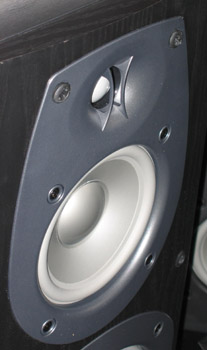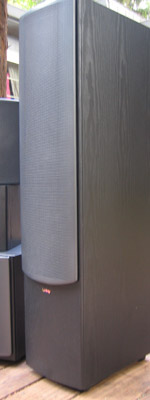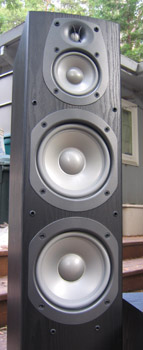Infinity Beta Series Speakers: 50 Towers, C360 Center, ES250 Surrounds, and CSW-10 Subwoofer Part I February, 2005 Colin Miller
Introduction
When I think of Beta and Infinity, I think IRS Beta, as in Infinity
Reference Standard Beta. Those with a connection to the vintage years of
Infinity, during the times of Arnie Nudell and Cary Christie, populated with
EMITs, EMIMs, and L-EMIMs, along with various other iterations of
different-looking, planar ribbon drivers, will remember that the �Beta�
version of the IRS family was a kind of little bother of the massive IRS.
Compared to the IRS, the IRS Beta was a much more practical animal.
 The IRS took up huge amounts of floor space with a tall line array of EMIT
tweeters and EMIM midranges mounted into a curved baffle about 4 feet wide.
That line array was then complemented by a tower of six 12�,
servo-controlled woofers. Double that arrangement and you had a stereo pair.
The last version of this setup, the IRS-V, went for about $60,000 a pair.
That's money now, and back then, it was real money.
The IRS took up huge amounts of floor space with a tall line array of EMIT
tweeters and EMIM midranges mounted into a curved baffle about 4 feet wide.
That line array was then complemented by a tower of six 12�,
servo-controlled woofers. Double that arrangement and you had a stereo pair.
The last version of this setup, the IRS-V, went for about $60,000 a pair.
That's money now, and back then, it was real money.
 The IRS Beta was a scaled down implementation of the same idea, but with a
single EMIT tweeter, single EMIM midrange driver, and a couple of L-EMIM
mid-bass drivers, all mounted to operate in a dipolar fashion, each
channel complemented with four servo-controlled woofers. The pair of
woofer towers and upper range arrays sold for a mere $12,000.
The IRS Beta was a scaled down implementation of the same idea, but with a
single EMIT tweeter, single EMIM midrange driver, and a couple of L-EMIM
mid-bass drivers, all mounted to operate in a dipolar fashion, each
channel complemented with four servo-controlled woofers. The pair of
woofer towers and upper range arrays sold for a mere $12,000.
 Fast forward to the recent past, and Cary Christie�s last project with
Infinity, to the best of my knowledge, was a scaled down, even more
practical IRS implementation, the IRS Epsilon. The basic layout was similar
to the Beta, except that all drivers were in a single cabinet, the EMIT/EMIM/L-EMIM
drivers were slightly updated, and there was a single 12�
servo-controlled woofer, and instead of dipolar operation, the planar ribbon
drivers directed the majority of their output forward, more like a direct
radiating speaker, almost, making it a much more practical speaker to place.
Price on those was about $14,000 for the pair.
Fast forward to the recent past, and Cary Christie�s last project with
Infinity, to the best of my knowledge, was a scaled down, even more
practical IRS implementation, the IRS Epsilon. The basic layout was similar
to the Beta, except that all drivers were in a single cabinet, the EMIT/EMIM/L-EMIM
drivers were slightly updated, and there was a single 12�
servo-controlled woofer, and instead of dipolar operation, the planar ribbon
drivers directed the majority of their output forward, more like a direct
radiating speaker, almost, making it a much more practical speaker to place.
Price on those was about $14,000 for the pair.
At one time my heart was set on the Epsilons, but due to constraints of money
and living arrangements, I eventually ended up with Infinity
Renaissance 90s, much like the IRS Epsilon in terms of the basic character,
but with a dynamic driver for a mid-bass, and a 10� Watkins woofer instead
of a servo-controlled 12� woofer. They were still nearly 4� tall, and kicked
tail while taking names, given the right kind of juice, particularly with
deep, tight, sometimes astounding controlled bottom-end performance.
However, compared to their heritage, they were virtually bang-for-the-buck
mini-monitors at a rock bottom price of $3,600/pair.
And there it seemed that Infinity, as I had come to know it, was coming to an end. There was a sputtering of the old guard with the IRS Sigma,
essentially an Epsilon with a conventional woofer and a Renaissance 90
mid-bass, but with increased rear output from the rear tweeter and thumpier,
higher Q bass that seemed to me a grab at novelty for the sake of
attention. At that point, Infinity started to Harmanize, and we saw
Composition Preludes with Home Theater voicing start to become the
company�s main focus. Now, sure, they were good products, and
immediately following Composition Overture 1s were some cool little
mini-monitors with powered 8� woofers, but they weren�t along the lines of
what interested me originally, and I followed other options.
So, when I heard about the Infinity Beta series, I was intrigued to see where things
had gone. Companies as large as Harman have the resources to pretty much do
what they want, should they choose to do so. As Infinity innovation can
benefit from the Harman umbrella just as easily as suffer from it, I had a
personal inclination to accept an invitation to have a full 5.1 setup take
temporary residence in my home. It
would have been nice to have still had my Renaissance 90s for comparison,
but alas I had released them to a friend to eventually land some M&K S-150P
active monitors for the LCR front channels years ago. I don�t regret the
course taken, but I occasionally miss those beautiful, quasi-monolithic Ren
90s.
I should admit that ever since experiencing Revel Ultima Salons, properly
set up in a good room a few years ago, driven by a Meridian 800/861 front
end and some Wavestream Kinetics amplifiers, I�ve had a profound respect for
what a Harman company could do, given the resources and freedom to excel in
the high-end market. Still, Infinity as a brand is no longer positioned for
the upper end of the audio market, but rather what one might refer to as
either mid-level or upper entry-level. Still, I had attended a couple of
talks by Dr. Floyd Toole, who works for Harman, and who had convinced me that
the majority of what defines a good loudspeaker need not require exotic
drivers, extreme build quality, or otherwise esoteric measures, but could
simply be accomplished by solid, grounded, well-tested design. While I
certainly benefited from elaboration of details and examples of measurements
showing why this was so, it also coincided with my personal experience, in
that I had gradually become disillusioned with the more �tweak� and elitist
philosophies to which I had previously subscribed, and so perhaps it was
time to check back into Infinity, not to relive the glories of the best
products I remembered, but to see how they had come along in their new found
direction.
Upon Arrival
 The Infinity Beta series
does not have the exotic techno-oriented appearance of the classic Infinity
designs. Still, they do seem quite sensibly shaped, and very solidly
built, and at a casual glance they certainly do have a certain cool factor to
them.
The Infinity Beta series
does not have the exotic techno-oriented appearance of the classic Infinity
designs. Still, they do seem quite sensibly shaped, and very solidly
built, and at a casual glance they certainly do have a certain cool factor to
them.
The packing isn�t extraordinary. No double-boxed or crated arrangements,
just Styrofoam on both ends and a little plastic to keep spilled sodas in
the warehouse off the merchandise, but it worked well enough to get the
speakers to me in fine condition. One of my cats quickly remedied that
achievement by knocking a surround speaker off a 3 foot counter, but the
construction was solid enough such that the only damage was cosmetic, a
slightly bent corner and a grille with snapped posts. I look forward to
getting the bill!
The cosmetics, though nice and modern, are not this speaker�s finest selling
point. The surface is very obviously a vinyl laminate, and the seams are on
the rough side. However, in terms of where it counts for sound, the
enclosures are entirely adequate, with nice solid construction. A definite
upside is that you no longer have to take out a second mortgage to own a
full set of Infinity speakers, and that will please a lot of consumers.
Due primarily to panel size, the subwoofer and surround enclosures were the
most inert to knuckle knocks, followed by the center channel, and then the
tower speakers. I should note that while knocking on a loudspeaker enclosure
is a good rough test to check out the enclosure�s damping and bracing, it�s
not really any kind of accurate indication of how much the cabinet will
contribute, or not, to sonic colorations (such as added harmonics, blurred
transients, etc.), that would make the sound more �boxy�, etc.). This is because drivers mounted on
the front baffle radiating sound into the loudspeaker enclosure will not
energize the enclosure panels in the same way as a knuckle impact from an entirely
different location. But it�s still fun to bang on the box.
The midrange drivers and tweeters for the towers, center, and surround
speakers are built into what Infinity calls a "Constant Acoustic Impedance"
baffle. That�s a fancy way of saying wave-guide.
 In the more common approach of dealing with diffraction, if it�s dealt with
at all, the tweeter gets mounted flush to the front baffle, so to minimize
any edges the sound waves would �see� as they rolled across the front
surface of the loudspeaker. Then, to address the edges of the cabinet that
could potentially cause diffraction artifacts (when a wave suddenly
encounters a change in boundaries, it can essentially �bounce� and radiate
out from the edge of the surface, creating secondary launches from the
speaker,) we might see either foam/felt to absorb the portion of the waves
that could become problematic at the edges, or radius the edges of the
enclosure in the hopes that the transition is more gradual and minimizes the
diffraction reflection. However, while a modest radius helps, if you really
want to avoid diffraction by curving the edges, those curves need to have a
radius in the span of multiple inches, far more than the mass production of
affordable �box� speakers allows.
In the more common approach of dealing with diffraction, if it�s dealt with
at all, the tweeter gets mounted flush to the front baffle, so to minimize
any edges the sound waves would �see� as they rolled across the front
surface of the loudspeaker. Then, to address the edges of the cabinet that
could potentially cause diffraction artifacts (when a wave suddenly
encounters a change in boundaries, it can essentially �bounce� and radiate
out from the edge of the surface, creating secondary launches from the
speaker,) we might see either foam/felt to absorb the portion of the waves
that could become problematic at the edges, or radius the edges of the
enclosure in the hopes that the transition is more gradual and minimizes the
diffraction reflection. However, while a modest radius helps, if you really
want to avoid diffraction by curving the edges, those curves need to have a
radius in the span of multiple inches, far more than the mass production of
affordable �box� speakers allows.
My Renaissance 90s addressed this by having relatively wide baffles, on the
order of 18� or so, that built in a gradual curve into the grille, a piece
of solid MDF with a slight curve on the end, meeting the edge trimmed by
solid wood with a roughly 2� radius on each side. The really wide baffle
with the gradual curve meant that most of the treble that would otherwise
hit an edge wouldn�t. And, because of the relatively large radius at the
edge, whatever made it that far would transition into the different acoustic
impedance fairly gradually. It was a fantastic way to address the issue,
though the build requirements for the enclosure were prohibitive for
cost-effective mass production.
What a good wave-guide does is apply a similar approach, but instead of
starting with a flat baffle, mounts the tweeter (or sometimes midrange) driver
inset into the enclosure behind the plane defined by the outer boundaries of
the front panel, so that the baffle is actually concave, somewhat like a
horn, but less extreme. Then, that surface is shaped to provide a more
gradual transition in acoustic impedance so that the baffle actually
intentionally and carefully controls the wave launch.
According to Infinity, "The wave-guide is used to match the directivity of
the tweeter to the directivity of the driver below it (mid in the Beta 50
and C360, woofer in the ES250). The primary benefits are controlled
dispersion both on- and off-axis, improved directivity integration with the
other drivers, and enhanced audible acoustic headroom. Also, regarding the CMMD technology (see three paragraphs below), the ceramic material is deep
anodized (grown on) to an aluminum core and makes up 40% of the diaphragm.
It is not really damping stuff or material on the aluminum cone. Both the
CMMD cone and process are patented. This is something special. As you know,
the goal with any driver whether it is a traditional dynamic driver or an
electrostatic panel is to control unwanted flexing or bending of the
diaphragm material. CMMD does this very well. They are incredibly pistonic
and push the first breakup mode of the cone well beyond its operational
range."
If done well, the wave-guide can minimize the diffraction artifacts that would otherwise
smear time response and rough up the frequency response in the top end, as
well as control dispersion to a degree, much in the way that horn-loaded
drivers can avoid much side and ceiling/floor reflections by directing sound
away from those boundaries from the get go. While I don�t know if this
degree of wave guide would qualify as a horn, it is a bit �horny� in that
respect.
While skirting this subject, I would interject that while the consumer
market, and even the professional market, has seen a whole bunch of honky,
nasal, harsh-sounding horn-based loudspeakers, if the horn is designed well,
the sound quality need not suffer for it, and may even substantially benefit
not only in dynamics, but many other attributes that us audiophiles lap up.
The JBL K2 S9800SE loudspeaker is a great testament to that notion.
However, that is a mighty big if, as it�s a whole lot easier and
probable to design an inferior horn than the other way around.
 All driver diaphragms are constructed of a material that Infinity calls
"Ceramic Metal Matrix Diaphragm", or CMMD. We can just say metal drivers with
some damping stuff on it. A property of metal drivers most desired by those
who choose to use them is their rigidity. Because of their stiffness,
compared to diaphragms made of more flexible material, metal drivers can put
off cone �breakup� until higher frequencies, operating in a more �pistonic�
fashion that many consider a theoretical ideal. However, one concern with
metal cones is that when they do reach their breakup range, they can ring
sharply and heavily, resulting in a sharp response peak a dragging out
transients at that frequency.
All driver diaphragms are constructed of a material that Infinity calls
"Ceramic Metal Matrix Diaphragm", or CMMD. We can just say metal drivers with
some damping stuff on it. A property of metal drivers most desired by those
who choose to use them is their rigidity. Because of their stiffness,
compared to diaphragms made of more flexible material, metal drivers can put
off cone �breakup� until higher frequencies, operating in a more �pistonic�
fashion that many consider a theoretical ideal. However, one concern with
metal cones is that when they do reach their breakup range, they can ring
sharply and heavily, resulting in a sharp response peak a dragging out
transients at that frequency.
It is conceivable that the fancy damping material portion of these metal
cones substantially reduces that problem, if not eliminates it, but I have a
suspicion that the nice fat butyl surrounds on the midrange and woofer
cones, themselves a highly damped material, don�t hurt the damping of the
cones either, and may be even more significant than any �ceramic matrix.�
Even then, with such a driver, we would expect that a good crossover would
prohibit any significant content beyond the driver�s optimal range, and as
such avoid the brunt of the ringing issue from the start. And, when it comes
to tweeters, if you can push the breakup range beyond human hearing, that�s
a nice solution too!
I would again like to spin off and interject that a flexing diaphragm is not
necessarily bad, so long as it doesn�t mean standing waves on the diaphragm.
After all, I�ve heard some pretty decent electrostatic panels, and if their
membranes didn�t flex, they simply wouldn�t work, would they? In fact, a
controlled flexure of a cone speaker can actually widen a cones dispersion
pattern at higher frequencies, which if you�re trying to get the most range
out of the driver without �beaming,� can be a really good thing, but I
digress too far, again.
Go to Part II

